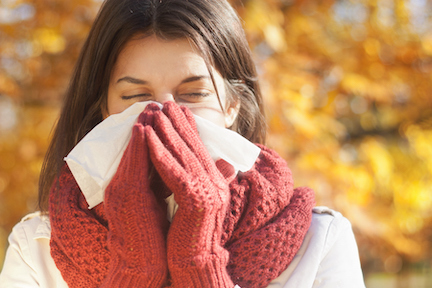
Fall allergies (sometimes called seasonal allergies or seasonal allergic rhinitis) usually occur between the late summer in August through November. It’s like clockwork. If you have fall allergies, you know how debilitating it can be. The sneezing and itchy, watery eyes can leave you feeling exhausted. For many people, this results in missing work and school. It even forces many people who have fall allergies to stay indoors and miss outdoor activities, like camping, hiking, hayrides, bonfires, and sporting events.
Path to Improved Wellness
The following symptoms are common fall allergy symptoms:
- Itchy, watery eyes
- Itchy nose and/or throat
- Runny nose
- Sneezing
- Nasal congestion
- Allergy asthma (asthma brought on my exposure to allergens)
What causes fall allergies?
The most common cause of fall allergies is a ragweed allergy. This wild plant grows in nearly every part of the country. It is more likely to be found on the East Coast and in the Midwest. The plant’s blooms spread ragweed pollen, which is what causes allergies symptoms. The higher the pollen count, the worse your symptoms can be. In many parts of the country, ragweed pollen is highest in early to mid-September.
In warmer parts of the country, or during mild winter temperatures, some ragweed could continue to be a problem. Some people are allergic to grass. That, too, can cause fall allergies in warmer climates.
Other plants that trigger fall allergies include:
- Burning bush
- Cocklebur
- Lamb’s-quarters
- Pigweed
- Sagebrush and mugwort
- Tumbleweed and Russian thistle
Path to Improved Wellness
Knowing if you have fall allergies and what you are allergic to is a good first step to wellness. If you have experienced the symptoms described above, make an appointment with your family doctor. They will evaluate your symptoms and may refer you to an allergist for more testing.
An allergist will ask you about your symptoms and whether your family members have certain conditions. These include asthma or allergies such as hay fever, hives, or skin rashes like eczema. After the allergist does a physical exam, they will do skin testing.
Skin testing involves lying on your stomach while the allergist pricks the skin on your back with tiny needles. The tiny needles contain a small amount of plant pollens on the tip of the needle. The allergist also can test for other things, such as mold spores, dust mites, animal dander, insect stings, and various foods such as peanuts, eggs, wheat, shellfish, and milk. Testing also is available for some medicines, such as penicillin. The pricks are painless and there’s not enough of the pollen to cause a serious reaction. If you are allergic to something on the needle, it will appear as a little red bump on your skin. A blood test also can determine if you are allergic to certain things.
Once the tests are complete, your allergist will go over the results with you. You may be allergic to certain plants, certain foods, or a combination of the two. This information allows you to be better informed about the things that bother you and help make decisions about certain activities (and foods).
How to treat fall allergies
Depending on severity of your fall allergies, your family doctor or an allergist may recommend treatment in one of several ways:
- Prescription or over-the-counter medicine: This depends on your symptoms and typically includes antihistamines, decongestants, nose (nasal) sprays, or eye drops.
- Immunotherapy (allergy shots): The shots contain a tiny amount of the allergen that you are sensitive to. But the dosage increases over time. Often, it is given in shot form. But it can be given under the tongue. The idea is to gradually desensitize your immune system to the things that causes your allergies. Over time, this approach can make you less sensitive to it. And that reduces your allergy symptoms when you are exposed to it. Immunotherapy also reduces the inflammationthat comes with hay fever and asthma. Sometimes, you may need to take an over-the-counter allergy pill if you are exposed to larger amounts of the allergen.
- Lifestyle changes: This may involve limiting your time outdoors during the fall, wearing a mask if you must be outdoors for lawn care, keeping your windows closed to your home and car, and cleaning your house regularly to eliminate pollen, mold spores, or pet dander.
Things to Consider
Fall allergies can be a life-long challenge, even if you undergo immunotherapy. If you do not get immunotherapy, fall allergies may negatively influence your participation in certain activities, and that affects your quality of life. You will need to remember to take your prescription or over-the-counter medicine if you do not get immunotherapy.
If you choose immunotherapy, it will be an investment in time. It can take about 5 years to complete the therapy. It will involve weekly visits for the shot and gradually ease into monthly shots. However, if you miss a dose, you may have to go back to weekly visits to catch up. Depending on your insurance, immunotherapy can be a financial investment for those five years.
Questions to Ask Your Doctor
- Do I have allergies?
- How can I tell the difference between allergies and a cold?
- Can over-the-counter medicine relieve my symptoms?
- Does over-the-counter medicine make you sleepy?
- How do allergy shots work?
- What if the allergy shots don’t work?
- Can I take the shots if I’m pregnant?
Resources
![]()
Copyright © American Academy of Family Physicians
This information provides a general overview and may not apply to everyone. Talk to your family doctor to find out if this information applies to you and to get more information on this subject.







